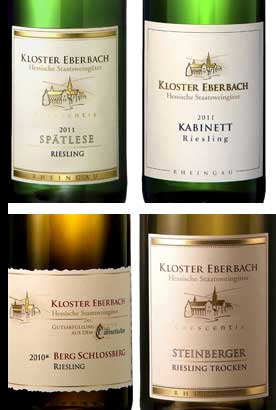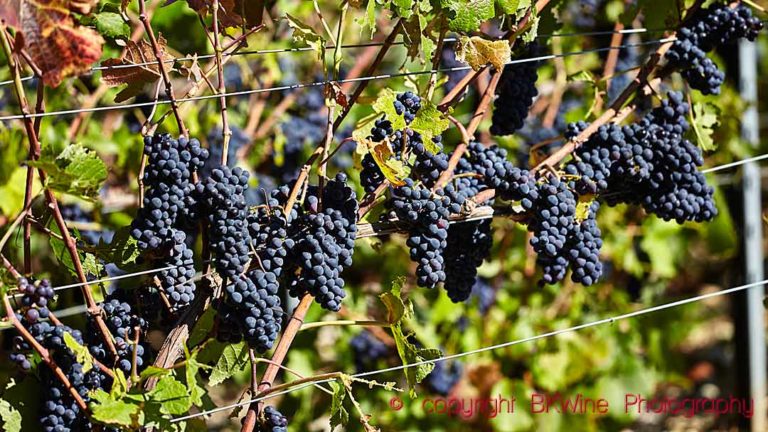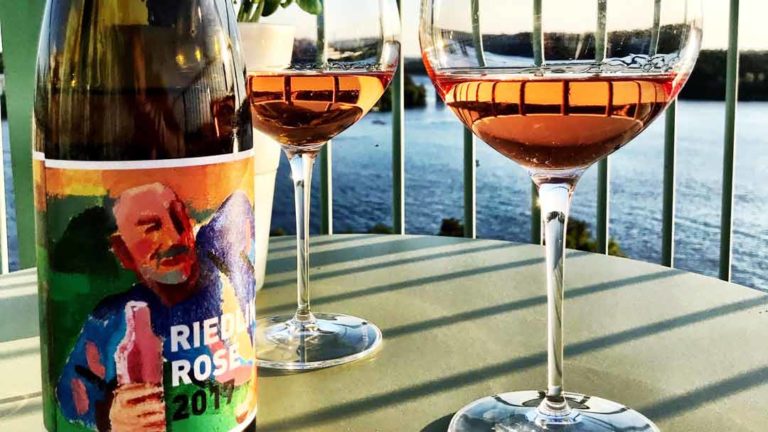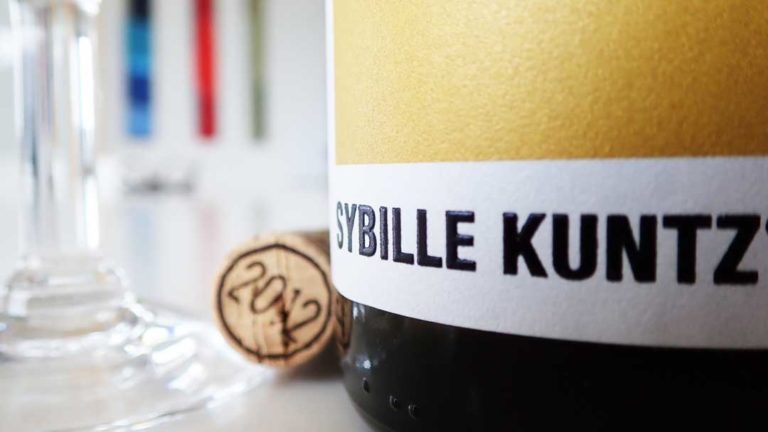Kloster Eberbach is a German wine producer with a very long tradition. They own vineyards, and produce wines, in the Rheingau and in Hessische Bergstrasse, from, in a German perspective, very extensive vineyards. Their range of wines is broad, including dry whites, sweet whites and reds. In recent years they have much improved the quality of their wines, as we could see in a recent tasting. BKWine’s reporter Tomas Eriksson reports.

Kloster Eberbach is a large German wine producer in the two wine regions Rheingau and Hessische Bergstrasse. Their owners are the federal land Hessen. The formal name is Hessische Staatsweingüter Kloster Eberbach. It is a tradition-bound producer who in recent years has significantly improved the quality of its wines. Their new Swedish importer Bibendum recently invited to a tasting with their CEO Dieter Greiner.
Cistercian monks. Again.
Kloster Eberbach has its historical origins in the extensive Cistercian monastical wine operations along the Rhine, which was centred in the Eberbach monastery. The monastery was founded in 1136 and is located above Hattenheim in the Rheingau. The monks had come from Citeaux in Burgundy, where Clos de Vougeot is their most famous vineyard.
With the Napoleonic invasion church property was confiscated in the German areas as had occurred in France during the Revolution. In the case of Kloster Eberbach this occurred in 1803.The church did not get back their property after the The Emperor and his troops had been driven out a few years later. They have been in public ownership ever since. From 1803 this meant the Duke of Nassau, from 1866 it was Prussia (the property then first named Königlich Preussische Domäne and later Preussische Domänen-Weinbauverwaltung) and from 1945 the federal state of Hesse.
Assmannshausen, Steinberg and Bergstraße
220 hectares of vineyards makes them Germany’s largest vineyard owner. They have above all a fantastic set of vineyards in the Rheingau, spread throughout the district. The vineyards are divided into three domains, each with a wine cellar: Assmannshausen for red Rheingau wines, Steinberg for white Rheingau wines and Bergstraße for wines from the eponymous district.
Worth a special mention among vineyard holdings are monopoly property Steinberg and the traditional red wine vineyard Assmannshäuser Höllenberg. Steinberg is the “backyard” vineyard a stone’s throw from the Kloster Eberbach. It is a walled clos which is half the size of the Clos de Vougeot in Burgundy. I myself have always been fond of the riesling wines from Rauenthaler Baiken, that tend to be consistent in style and quality, and characterized by distinct mineral notes and elegance.
Face-lift

The Kloster Eberbach winery has in recent years undergone a significant makeover. They have built a new ultra-modern cellar outside Steinberg, inaugurated in 2008. From the 2008 vintage, they have eliminated cork defects by introducing screw caps on the entire range, including the “auction editions” of noble sweet wines that cost several hundred euros per bottle. A very commendable step for such a traditional producer!
They have also changed the labels so now it is the monastery silhouette that appears on the front rather than the German Eagle, which is common in many government contexts in Germany but that some apparently perceived as a bit too much “war like”. The eagle is not completely removed, it now breeds on the back label in reduced size.
The most important part of the change, however, is in the quality of the wines. Even before I think they often did good sweet wines and their red wines have long had a good reputation in Germany. Since some vintages also their dry wines are of really high quality throughout. I saw it clearly when I visited them at the beginning of the year and tried many 2011s. The impression was confirmed now in the tasting of the 2012s. The wines now have a great purity of aromas and the elegance that you want a Riesling to have. Furthermore, they show clear style differences between the different vineyards.
Three quality levels: Cabinetkeller, Crescentia and Gutsweine
The range has been structured with three quality levels called Cabinetkeller, Crescentia and Gutsweine. The split on three levels is a structure that many producers in the VDP quality growers’ organization apply and is fundamentally nothing new at Kloster Eberbach either. However, what is new is that the bottles and labels now differs more between the three levels. They have thus become more clearly separated, and they have reintroduced some old time-honored terminology.
The highest level is called “Cabinetkeller”. Here are the best dry wines – equivalent to Grosses Gewächs from other VDP producers – and the noble sweet wines of Auslese quality and above. The labels are recognisable by their distinctly red text and have the most “retro” look, with “torn” edges and the word “Cabinetkeller” in old-fashioned font borrowed from Preussische Weinbaudomänes labels from around 1900. They are also bottled in bottles a little higher than that of other of wines.
Why this name? Well, the cabinet cellar (keller) was the cellar of convent where the best wines were saved to be sold later. This therefore corresponds vaguely to the term “reserve” in French and English. The old-style spelling, Cabinet, is used to try to avoid confusion with the more recent predikat Kabinett, which was introduced only in 1971.
The middle tier is called “Crecentia”. This is mainly wines from specific, high-quality vineyards, but for wines that are not in the highest Cabinetkeller level, and for some better wines that are not single vineyard wines. At this level there are both dry and semi-dry wines, and the classification is Qualitätswein, Kabinett or Spätlese.
On the front label they only use Kabinett and Spätlese for the semi-dry wines and dry wines are marked Trocken. The labels can be recognized by quite a large drawing of the monastery on the label with the text “Crescentia” underneath, and distinctive golden edges. The Crescentia level now includes a lot of really good wines at reasonable prices!
The lowest level is called “Gutsweine”. These wines have no vineyard designation, but only a grape variety and region designation and are the producer’s simpler wines. The labels have a smaller image of the monastery and more sparse use of the gold colour. They also have a simpler form of screw cap with a visible thread. Some of them are sold in a bordeaux bottle.
Dry riesling, wines

Wiesbadener Neroberg trocken 2012 (Crescentia)
Aromas of apple, hints of elder, slightly citrusy and minerals, some spice. Relatively discrete nose for a young Riesling, but also quite spicy. Dry taste, distinct fruity with melon, honey, good concentration and good acidity. Chewy style. 87 p.
The Neroberg vineyard was returned to Kloster Eberbach from the city of Wiesbaden in 2005, and it is a bit peculiar in that it has volcanic soils.
Steinberger trocken 2012 (Crescentia)
Aromas of apple, some white peach, mineral, blackcurrant, elderberry and typical Riesling perfume. Dry palate with yellow apples, good concentration, honey, some mineral, light spiciness, good acidity. Chewy, good to drink now. 88 p.
Steinberg is a very classic vineyard and has also produced a classic Rheingau riesling with decently ripe grape character and typically perfumed notes. Can in a way be described stylistically as somewhere between the two wines from Rauenthal. The wine’s quality level is really good relative to the modest price (~14 euro)!
Rauenthaler Baiken trocken 2012 (Crescentia)
Aromas of apple, a little elderberry, mineral, some blackcurrant and riesling perfume. Dry taste, clear minerality, apple and citrus, high acidity, and an aftertaste dominated by mineral. Relatively young, reasonably OK to drink now, 88+ p.
As usual Baiken was my favourite. It was also the most in need of aging and most mineral of the dry Crescentia wines in the tasting.
Rauenthaler Gehrn trocken 2012 (Crescentia)
Aromas of ripe yellow apple, a touch of melon and white peach, hint of honey, some mineral, light floral tone. Dry but with a little sweet fruit, the taste of yellow apple, honey, a little spice, good acidity, aftertaste with apple and citrus. Great to drink now, 88 p.
Gehrn is apparently their winemaker’s favourite vineyard. This wine shows the most mature fruit of all, which comes from the grapes growing in a steep south facing position.
Rüdesheimer Berg Rottland trocken 2012 (Crescentia)
Expressive aromas of white peach, elderberry, some mineral, black currant leaves and quite perfumed. Dry but with a little sweetish fruit, good concentration, fruity aftertaste. 86 p.
Also Rottland is a good wine, but did not quite reach the same precision as the other Crescentia wines in this line-up.

Rüdesheimer Berg Schlossberg 2012 (Cabinetkeller)
Elegant aroma with citrus, including citrus peel, apple, clear mineral tones, understated perfume. Dry, rich concentration of citrus, some apple, clear mineral tone, high acidity, aftertaste of green apple and mineral. Clean and elegant tones, young, 91+ p.
Here we went up to the highest level in the dry range. This is wines where aging and drinking with food is almost obligatory. Here Kloster Eberbach shows that they can cope with the steep vineyards of Rüdesheimer Berg. This is what a Riesling from there should be like!
Riesling, semi- dry wines
Steinberger Kabinett 2012 (Crescentia)
Aromas of peach, citrus and mineral. Semi-dry flavour, good concentration, honey, citrus, peach, good acidity. Young, drinking well now, 88+ p.
A higher quality level of Cabinet than the latter wines. It is not more heavy or powerful, but its higher acidity makes it rather a little less sweet. This wine shows a little more elegance, clear mineral tone and will benefit from aging.
Kloster Eberbach Riesling Kabinett 2012
Aromas of peach and a little honey. Semi-dry flavour, a little spicy, perfectly good concentration, good acidity, fruity aftertaste. Relatively young, 86(+) p.
Interestingly, it felt in this vintage as if the Kabinett would have a little more to gain from aging than the Spätlesen. (around 11 euro)
Kloster Eberbach Riesling Spätlese 2012
Aromas of peach, honey and some wine gums. Semi-dry palate with peach, honey, and great acidity. Relatively young, 87 p.
Slightly sweeter and slightly heavier than the Kabinett, with clearer notes of botrytis, but the difference between them should not be exaggerated.
The last two wines are bottled especially for the Swedish market, and are the two wines Kloster Eberbach in particular are known for in Sweden.

These wines come from a mixed set of vineyards, and the grapes include overripe grapes sometimes affected by noble rot that are sorted out from the vineyards that are primarily intended for the production of dry wines. The aim is to mainly use grapes from Rheingau vineyards situated higher, but the origin can vary between vintages. The Kabinett wine is now a “Gutswein” label and the Spätlese is a “Crescentia” label.
Pinot Noir / Spätburgunder
Pinot Noir trocken 2011 (Crescentia)
Aromas of raspberry, red currant, floral notes and a bit of spice. Taste of raspberries, red berries, relatively light fruit, mild tannins, and a finish with somewhat tart berries. 83 p.
Assmannshäuser Höllenberg Spätburgunder trocken 2011 (Crescentia, Spätlese trocken)
Aromas of strawberry, bright cherry, light herbal notes, some spice and animal tones, light, flowery and slightly oaky notes. Medium-bodied, flavour with relatively ripe strawberries, clear spiciness, medium(-) tannins, good acidity. The aftertaste is spicy and juicy. This is a wine with a serious pinot noir flavour and good balance. 88(+) p.
Assmannshäuser Höllenberg Spätburgunder 2008 (Cabinetkeller, Spätlese trocken)
Aromas of strawberries, slightly dried red berries, some undergrowth, animal notes and a little maturity with slightly smoky tones and some barrels. Medium bodied (+) flavour with very ripe strawberries, a little sweetish fruit, mineral, slightly viscous impression, medium tannins and a slightly sharp alcohol, and an aftertaste of sweet strawberries. Relatively impressive for a fundamentally lighter vintage, but with a little overripe fruit and not a very Burgundian interpretation of the grape variety. 89p ?
A few of the tasted wines can be found in Systembolaget’s product range, and some are sold in the restaurant range. I hope in particular that we will see more of the dry riesling wines from Kloster Eberbach on the Swedish market in the future!
Tomas Eriksson is one of the contributors on BKWine Magazine. He is active in the wine tasting association AuZone in Stockholm and in Munskänkarna, where he sometimes holds wine courses. Tomas also runs a blog called Vintomas.










2 Responses